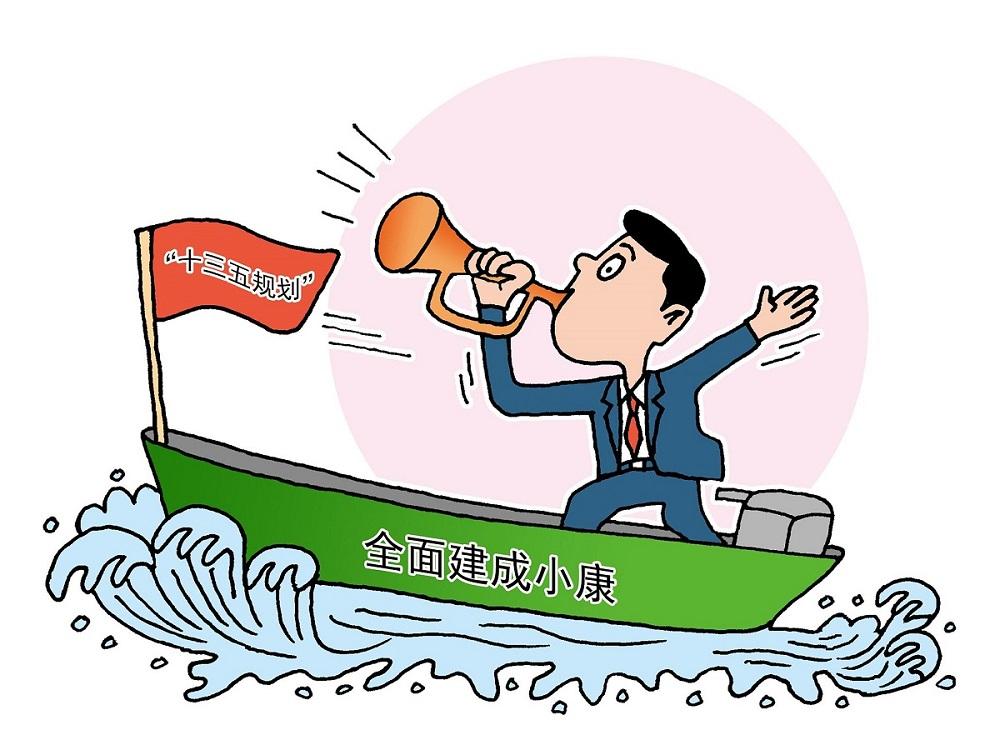Regret is for those without foresight. The same goes for countries, and for a country as extensive and populous as China, long-term planning is particularly important. Yet how does China formulate and carry out these plans?
Annette Nijs, former cabinet member in the Netherlands and renowned economist once said, “China is one of those countries which are very clear in their long-term planning. It planned and set targets far more clear than most European economies.”
Taking the goal of “building a moderately prosperous society” as an example, the concept first emerged in December 1979 when Deng Xiaoping met with Masayoshi Ōhira, the then Prime Minister of Japan. Subsequently, China carried out various projects that revolved around this concept in the 80s to the 90s in the past century, and work on building a moderately prosperous society entered full swing at the beginning of the new century. In 2017, the 19th Party Congress again emphasized the decisive importance of the period before 2020 for fully achieving a moderately prosperous society. As shown, the goal of building a moderately prosperous society has remained the same over 40 years since reform and opening-up started. There were several leadership handovers during the period, yet the nation’s programmatic goals and policies have remained stable and consistent.
The Chinese government’s success in maintaining steady progress must be attributed to China’s public policy coordination mechanism -- the Five-Year Plan.
China’s Five-Year Plans are the blueprints and masterplans for the next five years’ national economy and social development, embodying the government’s development strategy and overall ideas. Like an all-encompassing basket of policies, these plans determine the scope, direction and type of measures that need to be taken, what policies to set and lay out the government’s upcoming tasks.
As a forward-looking mechanism for public policies, this comprehensive development planning is era-spanning and covers a wide range of issues, demanding a high quality in policy-making that would be difficult for other countries to aspire to.
China is a vast and populous nation with 56 ethnic groups, 32 provinces, autonomous regions, municipalities and two special administrative regions. In addition, it has 15 sub-provincial cities and 334 prefecture-level divisions, all with different population compositions, climate and resource endowments. Formulating a common plan that takes into account the needs of diverse stakeholder groups and peoples, as well as achieving consensus between Central and regional governments, is no easy task. Despite this, China has been steadfast in constantly refining its planning mechanism.
Since the reform and opening-up in particular, China has adopted a strategy of “crossing the river by feeling the stones,” whereby ineffective policies are rescinded or adjusted and effective ones maintained. The role of planners has been modified, the importance and function of the Five-Year Plan in macroeconomic adjustment has been redefined, making it one of the three major macroeconomic adjustment measures alongside fiscal and financial policies, thereby safeguarding well-coordinated, balanced economic development.
Not counting the interrupted Five-Year Plan during the economic adjustment period of 1963 to 1965, as of 2005 China has implemented ten Five-Year Plans in total.
From the 11th Five-Year Plan in 2006 onwards, China has used the term ”gui hua” (計劃) instead of ”ji hua” (規劃) when referring to “planning,” to highlight the element of regulation and control (gui) rather than the element of strategic command (ji) in planning. Economist Zhang Lianqi gave a visual explanation, ”Jihua aims to have each tree reach a certain height and girth, while guihua makes an overall plan for the entire forest while letting each tree grow as it sees fit.”
From then on, the planning of the national economy and social development has come to mean strategic, programmatic and comprehensive planning. It also marked several transitions: from planning of command economies to planning of strategic development; from economic planning to planning of overall development; from micro-intervention to adjustment at the macro-level, and from achieving economic targets to achieving social welfare targets.
Most importantly, in addition to the existing “predictive targets,” the 11th Five-Year Plan introduced new “binding targets” (The Outline of the 11th Five-Year Plan mandates that the binding targets within the plan are legally binding and will be incorporated into existing systems for comprehensive review and evaluation of social-economic progress in all parts of the country and all government departments). Unlike the command-and-control economic targets set in previous plans, binding targets are different in that they represent the government’s pledge to society, and has a binding effect on government bodies instead of enterprises. This is especially the case for work on environmental protection, state-owned land use and provision of social services.
In reality, the 11th Five-Year Plan’s greatest success was in raising various departments’ awareness about carbon emission reduction, leading to a change in government behavior.
Yet how was the Five-Year Plan formulated?
Wang Shaoguang, Professor of the Department of Government and Public Administration at the Chinese University of Hong Kong, and Yan Yilong, Assistant Professor of the Center for China Studies, Tsinghua University, described in detail the 10 steps used to formulate the 13th Five-Year Plan.
The formulation of the 13th Five-Year Plan began halfway through the implementation of the 12th Five-Year Plan. The process took three years and involved four stages and 10 steps.
Four stages:
- Official compilation of the Outline of the FiveYear Plan (Outline)
- Recommendations for the FiveYear Plan (Recommendations) compiled by the Party Central Committee
- Research on basic concepts
- Midterm review
The Five-Year Plan enables the government to:
- Perform strategic coordination: determine the priority of national policies and perform coordination, adopting a predictive, comprehensive and longterm perspective;
- Preside over resource allocation: allocate and concentrate limited resources that policy makers deem essential for socioeconomic development;
- Perform macroeconomic adjustment: achieve previously set developmental targets by controlling the rise and level of major economic variables directly, using state intervention to prevent severe economic cycle fluctuations and to deal with external shocks.
Apart from fulfilling strategic targets, the Five-Year Plan also helps correct market imbalances, facilitate equal allocation of common resources and promote scientific development.
In the past 30 years, China’s economy has been vibrant thanks to the government’s visionary and comprehensive planning of economic, social, technological and environmental development. The mid and long-term plans cover all fronts, from infrastructural development like the space program and the high-speed rail network to areas like human resources, education, health care and hygiene, sports and culture.
Besides overall planning, the State Council can formulate and establish specific or regional plans and they will be incorporated into local planning, where they will be further optimized and refined. This is referred to as the “planning of the three levels and three categories” (state-province-city and overall-specific-regional) and forms an interwoven planning network that ensures all central government departments and regional governments play their designated roles in the Central Government’s pre-defined framework.
Regional plans like the Go West strategy and the revitalization of Northeast China have practical use in coordinating regional economic development. During plan implementation, allocation of funding and direct investment from the Central Government has a supportive or even decisive effect. Regional plans enable local and central decision makers to coordinate their policies and investments, as well as scope for policy flexibility for regional officials.
Specific plans, for example those on energy saving and carbon emission reduction, serve to coordinate interdepartmental and intergovernmental investment, monitoring and governmental action. They often involve the regulation of sectors like infrastructure, use and conservation of land and other important resources, environmental protection and public utilities.
Wang Shaoguang, Hu Angang, Yan Yilong and some others regard the Five-Year Plan system as an important measure for utilizing the “two hands” -- the government and the market -- and engaging the “two active parties” -- meaning the Central Government and regional governments. It plays a major role in promoting economic development.
The Five-Year Plan system provides space for the market to develop and the devolution of power by the government, while guaranteeing control of the economy by executive departments. Since the term guihua instead of jihua has been used, it has become a primary means for setting all kinds of public policies.
Through repeatedly process of democratic centralism, the Five Year Plan is able to reflect the nation’s strategic purpose to the greatest extent while fully expressing the needs of the masses. It reflects the Central Government’s strategic decisions and at the same time embodies regional demands for development, and thus provides a platform for different stakeholders and views to mingle, find a compromise and reach an agreement in policy setting. Hu Angang therefore believes that the Five-Year Plan formulation is a public decision-making process that best embodies Chinese characteristics, and represents the organic synthesis of democracy, centralization, decentralization and unification.
A plan’s formulation, followed by its implementation, evaluation and eventually the development of the next plan repeats itself as a strategic, cyclic process.
While each newly formulated Five-Year Plan locks on to a specific long-term goal, it does not mean that previous policies are to be completely abandoned in favor of new plans. Rather, amendments or additions are made based on the previous Five-Year Plan, taking into account the latest environment and changes in the development situation to adjust and improve existing goals. In this way, the Five-Year Plan helps maintain long-term stability while allowing flexibility.
Another characteristic of the Five-Year Plan is that its cycles are not in sync with Party and government office terms. Handovers of these posts take place in the middle of the five-year interval, and therefore the newly appointed leadership must spend their first three years on fulfilling the goals set by the previous leadership, creating a lock-on effect in terms of plan implementation, and thus ensure that policies are upheld despite the change in personnel.
As remarked by Annette Nijs, China’s long-term goal of building a moderately prosperous society is very clear from the very beginning. Major goals are broken down into smaller goals by the government and gradually implemented according to a series of Five-Year Plans. The outcome has proved the effectiveness of this measure.
References:
Red Swan: How Unorthodox Policy-Making Facilitated China’s Rise, by Sebastian Heilmann, The Chinese University Press
Red China, Green Cash Flow -- Turnaround of the Twelfth Five-Year Plan (十二五規劃的大翻轉) by Hu Angang (胡鞍鋼), Yan Yikong (鄢一龍), CommonWealth Magazine Co., Ltd. (天下雜誌出版社)
“Beijing Consensus” is a very good development mode -- interview of Annette Nijs, China Europe International Business School Executive Director, Global Initiative (「北京模式」是一種很好的發展模式——訪中歐國際工商學院全球策略總監安妮特·奈斯), xinhuanet.com, Dec. 14, 2008
Yan Yilong: Why Can’t India Catch Up With China? – Case Study of Transitioning under the Five-Year Plan (鄢一龍:印度為什麼追不上中國?——以五年規劃轉型為例), by Yan Yilong, guancha.cn, Aug. 15, 2013
An Analysis of the Strategic Design of Public Policy in the National Five-Year Plan (國家五年規劃戰略設計的公共政策分析), by Hu Angang, Jiang Jiaying (薑佳瑩), Lang Xiaojuan (郎曉娟), Journal of Beijing Jiaotong University (Social Sciences Edition) (北京交通大學學報(社會科學版)), 2014, Volume 4
Exclusive: Formulation of the 13th Five-Year Plan (獨家揭秘「十三五」規劃如何出爐?), Haiwainet.cn, Oct. 29, 2015
A Logical Review of Our Nation’s Five-Year Plan in a New Era (新時期我國五年規劃的邏輯探討) Liu Guoju (劉國巨), China Opening Journal (開放導報), 2015 Volume 1
Five-Year Plan (五年規劃) (documentary), China Central Television Business Channel






